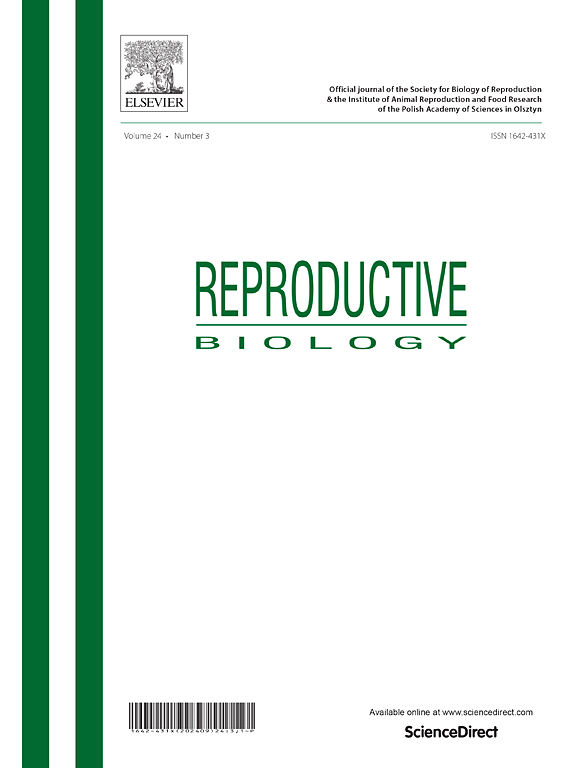Decoding ovarian aging in women: Cellular damage, signaling networks, and treatment frontiers
IF 2.5
3区 生物学
Q3 REPRODUCTIVE BIOLOGY
引用次数: 0
Abstract
Ovarian aging is a significant biological process characterized by the gradual decline of ovarian function and fertility in women as they age. It is a multifaceted process that involves various molecular mechanisms. This review article delves into the complex nature of ovarian aging, marked by reductions in both the quantity and quality of oocytes, hormonal imbalances, and heightened risks of infertility and pregnancy complications. It consolidates current understanding of the physiological, cellular, and molecular mechanisms driving ovarian aging, such as mitochondrial dysfunction, oxidative stress, telomere shortening, DNA (Deoxyribonucleic Acid) damage, inflammation, and apoptosis. This review primarily focuses on human ovarian aging, while also integrating relevant insights from animal models particularly rodent studies that have contributed to our understanding of underlying mechanisms. It explores key signaling pathways involved in aging, including AMPK (AMP-Activated Protein Kinase), mTOR (mammalian target of rapamycin), Nrf2 (Nuclear Factor Erythroid 2-Related Factor 2), SIRT1 (Sirtuin 1), and FOXO3 (Forkhead Box O Transcription Factor) pathways. The review also discusses emerging therapeutic strategies designed to delay or reverse ovarian aging, which include antioxidants, hormone replacement therapy, stem cell-based treatments, CRMs (CR mimetics), gene therapy, and traditional medicines. Additionally, the article examines the potential role of polyamines in ovarian function and aging. By thoroughly analyzing the current research landscape and identifying future research directions, this review offers valuable insights for researchers and clinicians dedicated to improving reproductive health and quality of life for aging women.
解码女性卵巢老化:细胞损伤、信号网络和治疗前沿。
卵巢衰老是一个重要的生物学过程,其特征是随着年龄的增长,卵巢功能和生育能力逐渐下降。这是一个涉及多种分子机制的多方面过程。这篇综述文章深入探讨了卵巢衰老的复杂性,其特征是卵母细胞数量和质量的减少,激素失衡,不孕和妊娠并发症的风险增加。它巩固了目前对驱动卵巢衰老的生理、细胞和分子机制的理解,如线粒体功能障碍、氧化应激、端粒缩短、DNA(脱氧核糖核酸)损伤、炎症和凋亡。本综述主要关注人类卵巢衰老,同时也整合了动物模型特别是啮齿动物研究的相关见解,这些见解有助于我们理解潜在的机制。它探索了与衰老相关的关键信号通路,包括AMPK (AMP-Activated Protein Kinase)、mTOR(哺乳动物雷帕霉素靶点)、Nrf2 (Nuclear Factor Erythroid 2- related Factor 2)、SIRT1 (Sirtuin 1)和FOXO3 (Forkhead Box O Transcription Factor)通路。本综述还讨论了旨在延缓或逆转卵巢衰老的新兴治疗策略,包括抗氧化剂、激素替代疗法、干细胞治疗、CRMs (CR模拟物)、基因治疗和传统药物。此外,本文探讨了多胺在卵巢功能和衰老中的潜在作用。通过对当前研究现状的全面分析和未来研究方向的确定,本综述为致力于改善老年妇女生殖健康和生活质量的研究人员和临床医生提供了有价值的见解。
本文章由计算机程序翻译,如有差异,请以英文原文为准。
求助全文
约1分钟内获得全文
求助全文
来源期刊

Reproductive biology
生物-生殖生物学
CiteScore
3.90
自引率
0.00%
发文量
95
审稿时长
29 days
期刊介绍:
An official journal of the Society for Biology of Reproduction and the Institute of Animal Reproduction and Food Research of Polish Academy of Sciences in Olsztyn, Poland.
Reproductive Biology is an international, peer-reviewed journal covering all aspects of reproduction in vertebrates. The journal invites original research papers, short communications, review articles and commentaries dealing with reproductive physiology, endocrinology, immunology, molecular and cellular biology, receptor studies, animal breeding as well as andrology, embryology, infertility, assisted reproduction and contraception. Papers from both basic and clinical research will be considered.
 求助内容:
求助内容: 应助结果提醒方式:
应助结果提醒方式:


